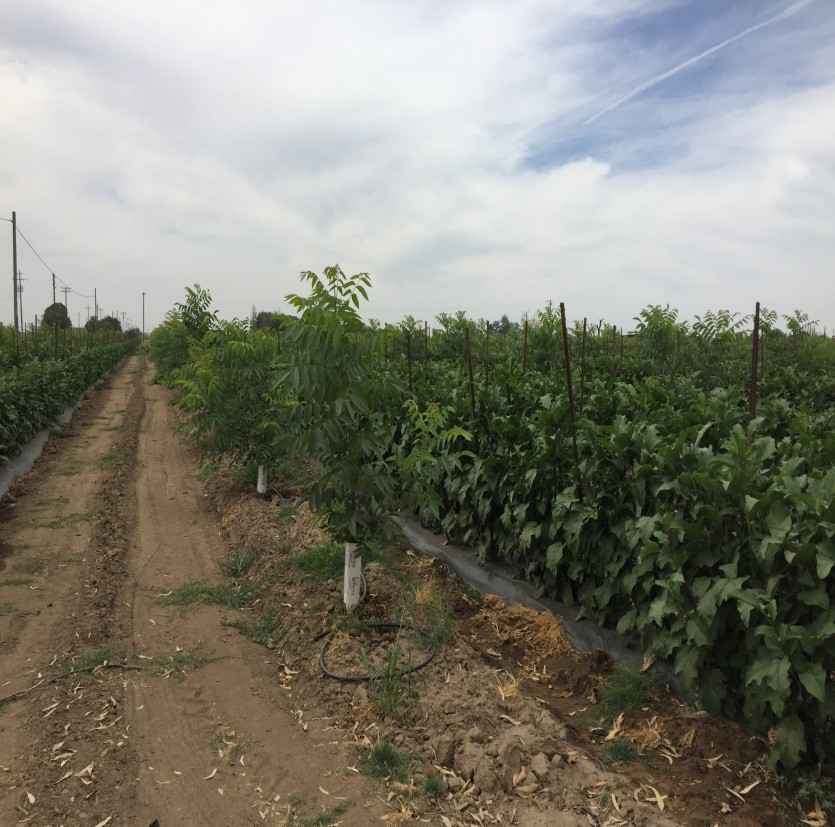Symptoms of foliar chlorosis on Tulare County walnuts indicative of over-irrigation
Elizabeth Fichtner, UCCE Farm Advisor, Tulare County
Bruce Lampinen, UC Extension Specialist, UC Davis
Although over-irrigation may seem like an unlikely diagnosis after an extended drought, the foliar chlorosis observed in Tulare County walnut blocks in late May and early June are identical to symptomology in research blocks maintained wetter than baseline (Figure 1).In research plots, foliar chlorosis occurs within just days of an excessive irrigation event. Note that the yellowing associated with overwatering affects all of the leaves on a shoot down to the nuts (i.e. neoformed leaves that were formed in the current season). In contrast, newly emerging leaves may initially appear yellow; however, they gradually turn to green three or four leaves back from the growing tip. Over-irrigated walnut trees in research plots also have a tendency to drop one of two nut doubles, resulting in lower overall nut retention in the canopy.When this situation is occurring, you can grasp a number of pairs of double nuts on the tree and one of each pair will often come loose with almost no force. These nuts will exhibit blackening while still on the tree (Figure 2) and squirt water vigorously when cut.Anaerobic conditions in the root zone may cause root rot which may lead to overall tree decline and mortality.
Over-irrigation of walnuts is common in young blocks where growers cultivate an annual crop in the middles of tree rows to maintain an economic return on the land in advance of tree maturation and productivity (Figure 3). The challenge to meet the irrigation demands of an annual crop may result in damage to the trees, thus affecting the future economic productivity of the orchard. Similarly, replants are often subject to over-irrigation because irrigation events are designed to meet the needs of the more mature trees. The root rot and tree decline resulting from over-watering is similar to the symptoms of root rot caused by Phytophthora spp.; however, isolation of these pathogens from the roots of overwatered trees is rare, suggesting that over-watering is the primary cause of decline.
Because orchards are dynamic ecosystems managed for economic return, irrigation events may be timed around factors other than tree physiology. For example, many growers in Tulare County were irrigating walnut orchards approximately a week in advance of the anticipated codling moth flight around May 30, 2016. These irrigations were timed to allow enough time for the orchard floor to dry in advance of pest management operations. In some orchards, irrigation events timed around pest management operations may be ill-timed with respect to tree water needs. Additionally, some irrigation districts in Tulare County had a release of Class 1 surface water in mid-May 2016. The timing of surface water availability and anticipated codling moth flight activity might have contributed to the over-irrigation and subsequent chlorosis in several Tulare County walnut blocks. Finally, over irrigation symptoms can occur when there is a period of hot weather with high rates of irrigation followed by a cool cloudy period.
Figure 2. Walnuts maintained wetter than baseline develop blackened nuts. Photo: J. Grant.
Figure 3. Some growers may grow an annual crop between the rows of new orchards. Meeting the irrigation demands of the annual crop without adversely affecting the trees poses a challenge. Photo: E. Fichtner
Use of a pressure chamber (aka ‘pressure bomb’) to measure stem water potential (SWP) will allow for direct measurement of tree water stress and thus assist with irrigation management. Most irrigation managers measure SWP prior to an irrigation and one to two days after an irrigation event. To reduce variability and achieve consistency in readings, SWP measurements should be made on bagged interior branches in the lower canopy during the afternoon. To maximize shoot growth and allow for sizing of nuts, SWP should be maintained from -4.0- -6.0 bars (low to mild stress) from leafout until mid-June. To control vigor without adverse effect on kernel development or fruitfulness in the successive season, trees may be maintained at -6.0- -8.0 bars (mild to moderate stress). For a comprehensive understanding of the use of the pressure chamber for measuring SWP in walnut, download the UC ANR article entitled “Using the Pressure Chamber for Irrigation Management in Walnut, Almond, and Prune” from the following URL: http://anrcatalog.ucanr.edu/pdf/8503.pdf. The article was composed by Allan Fulton, Joe Grant, Richard Buchner, and Joe Connell, UC farm advisors, and provides background on the use of the pressure chamber and interpretation of SWP data.





